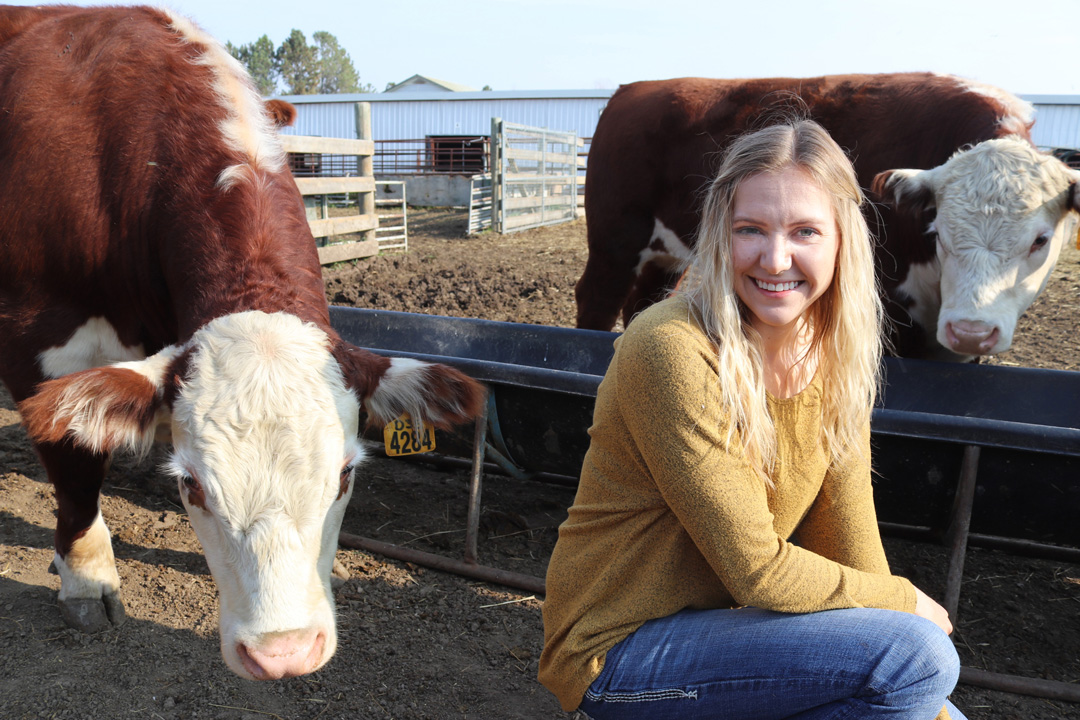
Tackling challenges with feedlot nutrition
USask graduate student Catherine Seidle adapts dairy-industry solution to discourage feed sorting by feedlot cattle.
By Kathy FitzpatrickJust add water.
That’s all it may take to maximize the nutrients beef cattle digest from barley when overcoming problems posed by variable kernel size—particularly feed sorting, where cattle pick through their diets.
Catherine Seidle, a graduate student in the University of Saskatchewan’s (USask) College of Agriculture and Bioresources (AgBio), is testing the theory in two studies she is conducting for her Master of Science (MSc) degree in Ruminant Nutrition. Her research, supervised by Dr. Greg Penner (PhD), is funded by the Saskatchewan Barley Development Commission (SaskBarley) and the Natural Sciences and Engineering Research Council of Canada (NSERC) Alliance Grants program.
Seidle calls the variable kernel size of barley “an undesirable issue” for feedlot operators. In searching for a research topic with practical significance that would lead to a solution “easily adoptable by producers” and offer “instant results,” Seidle believes she may have found it.
“This is such an easy tool. Everybody has water,” she explained. “If adding water is all it takes to get a more consistent intake, consistent growth, and consistent gains on these cattle, it’s an easy, low-cost win for feedlots.”
The first part of Seidle’s project is a metabolism study, looking to see if overprocessing barley and adding water reduces sorting behaviour, and how this impacts or changes digestion. For this, Seidle had to record feed and water intake, collect rumen fluid and fecal samples, and measure rumen fill from eight cannulated steers at the Livestock Research Building on campus.
Seidle’s second study is a larger feedlot study involving 120 steers at Agriculture and Agri-Food Canada’s Lacombe Research and Development Centre in Alberta. There, she is examining animal growth and carcass characteristics such as muscle mass and fat deposition—in other words, how adding water to rations impacts the quality of meat being produced.
The idea to add water seems to have come naturally to Seidle, given her background in Saskatchewan agriculture. She grew up on her family’s mixed farm near Colonsay, Sask., which includes a sizable cow calf and grain production operation. In 2017, she earned her bachelor’s degree in agriculture with a major in animal science at USask. She then worked at Blair’s Family of Companies, which provides farm and ranch services and supplies. Seidle then joined the Saskatchewan Ministry of Agriculture as a Livestock and Feed Extension Specialist. She is now on a two-year leave to complete her master’s.
At the ministry, Seidle fielded a lot of questions from producers regarding the maximum amount of grain they could feed an animal, as well as how to encourage feed intake so animals gain weight and muscle faster. “All of these concepts are wrapped into this project,” said Seidle.
The practice of adding water to rations is not new in other livestock sectors. “Dairy operations do this all the time to reduce sorting,” noted Seidle. “And cow-calf producers will do this too on high-forage diets that are dry. They add water to reduce dust, but (adding water) rarely ever happens in feedlots on high-concentrate diets.”
However, sorting is a problem in feedlots too, because of the very dry diets provided, and the variable kernel size of barley, which results from both overprocessed and under-processed kernels. Without processing, cattle can’t get the full nutritional value of whole barley. They are unable to break the hard outer coating of the kernels with their teeth, which therefore inhibits the microbes in their rumen (first stomach) from digesting the kernels. The barley must be broken for them.
In Saskatchewan, this is typically done by dry rolling the grain, where the kernels are squeezed between two rollers in a mill.
Dry rolling has its own challenges. Getting consistently uniform kernel size for rolling is practically impossible. As Seidle explains, in Saskatchewan hundreds of loads of barley arrive at elevators each week. Different varieties grown under different conditions and agronomic practices all get blended together. Therefore, when the kernels go through the roller mill, the smaller kernels pass through rollers unbroken. Larger kernels shatter, producing fine particles.
The underprocessed kernels pass through the animal undigested, so the starch ends up in the cattle’s manure “and that’s just costly nutrient loss,” said Seidle. Fine particles due to overprocessing are digested too quickly, causing rapid acid production (acidosis), reducing the rumen’s pH and killing off its microbes. Then the cattle “tend to stop eating because their stomach hurts.”
So why is sorting undesirable? Producers want their animals to take in a consistent mix with each mouthful, and sorting prevents this from occurring. Otherwise, they may eat all the roughage first, then eat barley for the rest of the day, moving to smaller and smaller kernels, and finally just fine particles which can cause digestive upset.
In feedlot pens, the dominant animals will eat mostly forage immediately, leaving less-dominant animals with a higher barley (and therefore lower forage) diet, potentially causing digestive upset. Adding water to rations creates a stickier mix that could reduce sorting. This in turn could lead to a more stable rumen environment, more predictable fermentation, consistent intake and consistent—or perhaps increased—daily gain.
Seidle doesn’t expect her project will be the final word on the subject, but “it is awesome to know that at the end of this … the concept of this could easily be extrapolated (in further research).”
Meanwhile, she hopes adding water to rations is “something feedlots could adopt in the next couple of years and help with animal health.”
Together, we will undertake the research the world needs. We invite you to join by supporting critical research at USask.

